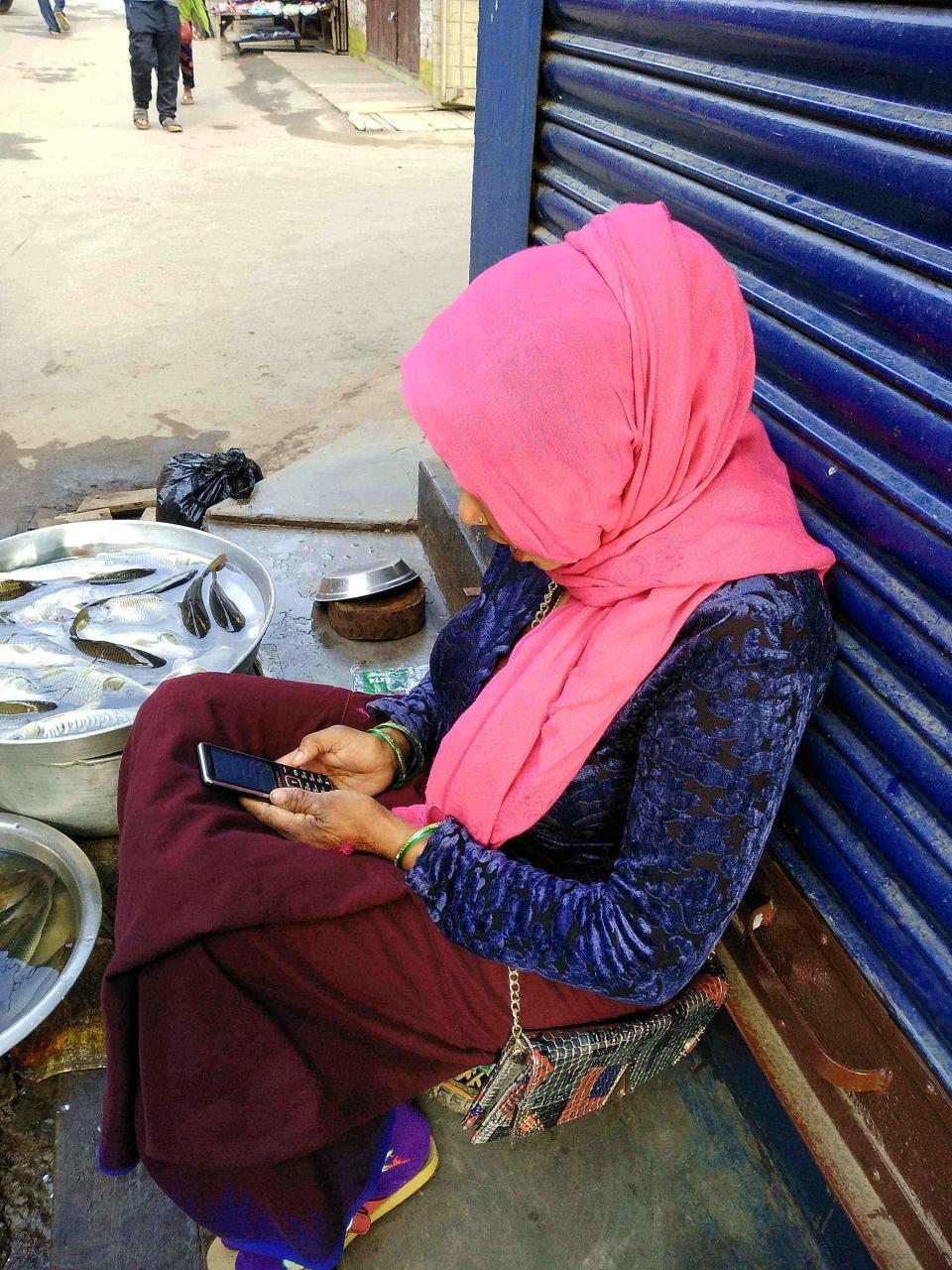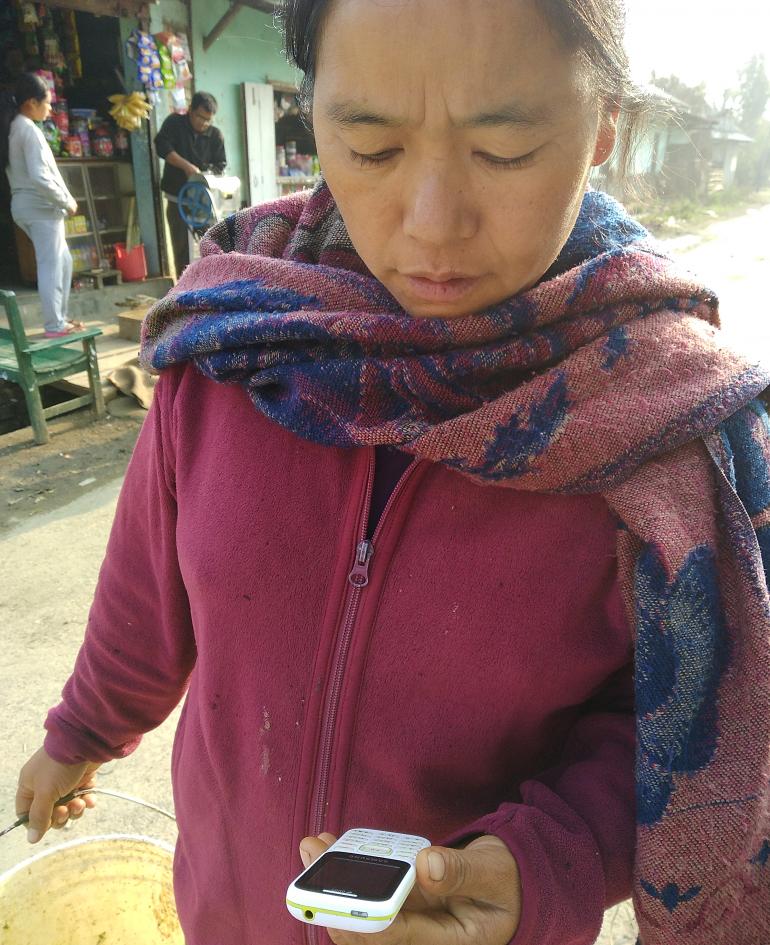
Image description: woman with mobile phone seated outside shop. Image source: author
The headline in a media report of March 23, 2017 ( ) says “BJP’s social media campaign in Manipur was a hit”. According to the report; the Bharatya Janata Party (BJP) kicked-off a high-pitched social media campaign in Manipur on more than 100 WhatsApp groups, a number of Facebook pages, Twitter handles and Twitter channels. This proves to be true considering the result. Comparatively in the 2012 state election, BJP had just 2.1% of the popular vote. In 2017 the BJP’s vote share rose to more than 36%. From less than a 1,000 likes on Facebook to crossing the 30,000 mark. The BJP subsequently formed the alliance government and is the ruling party of the current government in Manipur.
Interestingly the media report quoted Shivam, political consultant and member of the BJP’s EMT, and a graduate from the University of Michigan-Ann Arbor to have said, “social media is a powerful tool in shaping conversations. Even if a large part of a state’s population is not on social media and won’t vote for a party based on online posts, the medium helps us in influencing what people are talking about”.
Even if a large part of a state’s population is not on social media and won’t vote for a party based on online posts, the medium helps us in influencing what people are talking about
Meanwhile it is pertinent to note that women are not at the helm of the social media affairs. Most importantly the older generations. For instances a young woman voter was quoted in the media report to have stated that the youths in her constituency were active on Facebook. And that they would gather at some friend’s house every evening and some-one would read the Facebook posts out loud and discuss them. Obviously the women were not handling the social media but were the “listeners” and the target for the campaign.
As in other parts of the globe social media is being widely used in the state of Manipur as well. Every person, with exception of the older generation, the elderly, possesses a mobile phone. While mobile phones have been the most popular means for communication, it is the new medium for source and means of information sharing and circulation.
Women were not handling the social media but were the “listeners” and the target for the campaign.
Even as this is the context, many women in Manipur are not in this circle of social media or information communication network. The reasons could vary. Most commonly economy plays a major role, with lack of knowledge on use of technology as another key factor. In the whole technological/ digital revolution women are left out. While they still continue to engage in the house hold activity and are confined in their traditional roles and responsibility, technology comes in as the new ‘in-thing’ for men - both in the family or in social life.
The new younger generation are mainly the users of the new media. Ronica Vungmuankim, a TISS- Mumbai alumni, living in Lamka, Manipur, shares that she uses the medium for reading news- information and communication with her peers. Says Ronica “all my batch mate in my home town are on social media – mostly on Whatsapp and Facebook”.
All my batch mate in my home town are on social media – mostly on Whatsapp and Facebook
In Manipur at large Whatsapp is the most popular medium followed by Facebook. Though Twitter is considered the more powerful tool with no limit of followers, with more impact politically and socially, the medium is not popular in Manipur. For Ronica, Twitter is not user friendly, the reason being that there are barriers such as word limit and that most of her circle are not on Twitter “not many people I want to follow or learn from are on twitter” she said. For her Whatsapp is more convenient as it is more informal and has features for sharing pdfs, documents and others.

Image description: woman with mobile phone seated outside shop, smiling directly at camera. Image source: author.
In the case of rural women, Deborah Infimate who works with Rural Women Upliftment Society in Churachandpur tells that social media cannot be relied on for grassroots or ground mobilizations and communication. Says Deborah “important information cannot be relayed to them on social media”. The reason being that these women on the ground do not use the medium. “even if they have mobile phones, it is not smart phones” she says. On asked whether it is economy Deborah tells “even if they can afford they are not technical savvy”. Besides that, at home they are engaged in domestic chores and have no time to use the technology, and apart from that “their children would take the phones away” said Deborah. For important information and urgent matters Deborah says “we need to call them up and personally convey, at most times through word of mouth”.
Deborah has a Facebook account but mostly used it for personal – such as photographs or personal updates. Twitter, she feels, is mainly for the “intellectuals and the celebrities”.
Twitter, Deborah feels, is mainly for the “intellectuals and the celebrities”.
The larger population of women folk in Manipur are outside of the news media network. This is not the case only in rural areas of Manipur but even in urban settings. Women like Ranjeeta Sadokpam did use social media for communications and campaign. Sadokpam a scholar and associated with Human Rights Alert, who lives in Manipur’s capital Imphal, agrees that social media has enabled free communication and provides a platform and a medium of information dissemination, many of which are generally unreported or overlooked, such as incidents like domestic violence, harassments, human rights violations etc. Even as places like Imphal is an urban settings she tells “many do not use smartphones”
Sadokpam recalled that a women’s groups such as Extrajudicial Execution Victims Family Association in Manipur formed by widows, faced a huge challenge when they tried forming a simple “Whatsapp group”. The reason being that “most of them do not have smart phones, besides many could not read or write on smartphones” said Sadokpam. Messages or information on social media are mostly in English so this makes it even more unfriendly for many of the women who are less educated and technologically challenged. Sadokam said “they mostly do not understand and does not have the know-how to use the social media”. This is not limited only to those who are less well-off, or without access to education, or just older women unable to use technology because of a generational gap. Sadokpam says “many of my classmates are not on social media”. Sadokpam tells that many working women, professionals avoid the use of social media. The reason she says “they do not have time nor the space (private space or personal time)” . Many married women are cautious not to irk their in-laws “they have so many household chores, moreover they have to be careful with their in-laws who may not like their daughter-in-laws spending their time on phones or social media”.
Sadokpam recalled that a women’s groups such as Extrajudicial Execution Victims Family Association in Manipur formed by widows, faced a huge challenge when they tried forming a simple “Whatsapp group”.
Internet facility though has improved over the years. Grace Zamnu, a politician and member of Autonomous District Council in Churachandpur, uses her Facebook to connect with the larger audience “I post my activities as an information sharing”, and she said “internet connection has improved over the years”. But a vast majority of voters in her constituency of Muallum, a rural area, are not on social media. “Less than 10% of the younger generation of women in my area are on Whatsapp” said Grace, “beside illiteracy, they can’t afford smart phone or internet” she said.
Beside illiteracy, they can’t afford smart phone or internet
There is also the dark side of social media as well, where women are vulnerable to online abuse and trolls. This has also led to many avoiding the use of social media. Entrepreneur like Muktamani Moirangthem in Kakching, has opened a Facebook account but is not active. On asked why she is not active she shared “unknown people used to follow me, there are many undesired attention, people would send messages on inbox”.
Even as internet connection have improved or use of mobile phones have increased, many areas in rural Manipur have no mobile phone connectivity, let alone internet. For instance in Thanlon, sub-divisions of Churachandpur district, a PCO (public call booth ) still operates and even that is most of the time out of service with no connection. Many people are seen to come out on the roads to make calls or received calls on mobile phones in an attempt to get better connection in the interior villages.
Many people are seen to come out on the roads to make calls or received calls on mobile phones in an attempt to get better connection in the interior villages.
There is poor infrastructure and poor connectivity in most parts of Manipur. Moreover, women mostly depend on their husbands or male members of their family for any work related to online activity or technical-related work. Technology is a male domain and associated mostly with men or boys. Thus, the digital revolution gives more advantage to the men. Economy, education, empowerment plays a significant role for women to advance in technology.
The digital revolution gives more advantage to the men.

Image description: woman with mobile phone walking. Image source: author.
- 8137 views






Add new comment